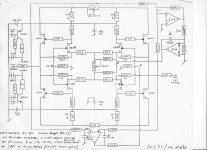Merry Xmas to you too, Scott. Yes, the JC-80 is a good example of what I am referencing. The Blowtorch is slightly more complex, so maybe the JC-80 would be good for a first example. If you want, please put it up, on line. I can do it, eventually, but I still have to lower my bandwidth to get anything on line.
Merry Xmas to you too, Scott. Yes, the JC-80 is a good example of what I am referencing. The Blowtorch is slightly more complex, so maybe the JC-80 would be good for a first example. If you want, please put it up, on line. I can do it, eventually, but I still have to lower my bandwidth to get anything on line.
OK I'll have to scan it in. Nice thoughtful circuit for the time and what you wanted to achieve BTW.
I thought so at the time. Now, I almost kick myself for small errors.
John,
You don't have to kick yourself, everyone here does it for you! Merry Christmas!
Ever onward, I wish to point out that I like to separate servos into two groups. One, Active, and the other, Monitor. While Active servos continually control small changes from whatever they are referencing to, Monitoring servos are much like Moderators (in the best sense) in that they prevent real problems, but don't participate in them, and therefore making them worse. This appears to be the fundamental mistake that designers, both professional or amateur, make with servos. They can be a problem, IF they cannot be kept out of the way of the audio program material. This is very important, and it is actually better to use a quality cap, IF you cannot decouple the servo from the audio program material. For example, trying to use the servo as a deliberate roll-off of the bass material.
A lot has been said on PIM in this thread. But here is the man who obviously has the answers:
http://www.diyaudio.com/forums/soli...listening-characteristics-15.html#post2021358
http://www.diyaudio.com/forums/soli...listening-characteristics-15.html#post2021358
A lot has been said on PIM in this thread. But here is the man who obviously has the answers:
http://www.diyaudio.com/forums/soli...listening-characteristics-15.html#post2021358
Yep I see you have some discussion going on at that thread, it’s quite amazing and he is a teacher in electronics?
BTW; please remember the “sin bin” my friend.
Cheers and merry Christmas
it’s quite amazing and he is a teacher in electronics?
BTW; please remember the “sin bin” my friend.
Yes, he is the one who prepares high school students in electrical engineering ......
.
.
I am trying to be as polite as possible, though it is not very easy.
Merry Christmas to you as well.
Regards,
Edit: please do not forget to follow the linked thread, things are actually getting interesting.
Last edited:
Hi Scott,
am I wrong or the VN and VP output jfets are exchanged ?!
eD
John should comment, it's just a scan of what he sent me 25yrs. ago.
As promised with JC's permission this is the JC-80 line stage. John you may want to comment on the crossed out/unreadable values.
There are also some bugs in the schematic (mostly missing wire junctions and a few parts values) but, as you said, looks good for the time.
There are also some bugs in the schematic (mostly missing wire junctions and a few parts values) but, as you said, looks good for the time.
It does?
I've worked on old Sansui, Marantz and Sony (and other) pre/control amplifiers older than that that were lightyears ahead in terms of sophistication.
Everyone, this is a working schematic made by Peter Madnick, formerly president of the company, and he made the oversight. However, that is an example of something that we often overlook or change on our own personal working schematics, as we note this slight mistake. This schematic was never made for publication. It will have a few errors, as it was not checked and re-checked by 3'rd parties for errors.
For example, in 1967, when interviewing for my job at AMPEX, I was asked to look at a schematic of a line driver/amp and explain it. The first thing that I noted is that the bias diodes were upside down and the amp would self destruct on turn-on. This was noted by my interviewer, but I don't think that was the test. It was easy for me to see it, because I was NOT intimately familiar with that particular design. This is what schematic checking is all about.
For example, in 1967, when interviewing for my job at AMPEX, I was asked to look at a schematic of a line driver/amp and explain it. The first thing that I noted is that the bias diodes were upside down and the amp would self destruct on turn-on. This was noted by my interviewer, but I don't think that was the test. It was easy for me to see it, because I was NOT intimately familiar with that particular design. This is what schematic checking is all about.
Complexity does not equal sophistication.
Sure, a circuit highly reliant in semiconductor matching for performance and a dozen opamp servo's does.
- Status
- Not open for further replies.
- Home
- Member Areas
- The Lounge
- John Curl's Blowtorch preamplifier part II
